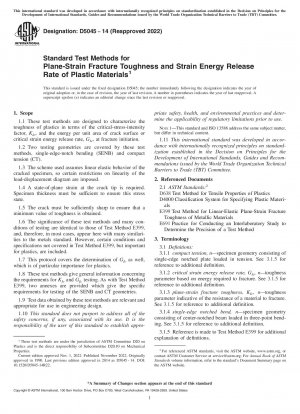ASTM D5045-14(2022)
Standard Test Methods for Plane-Strain Fracture Toughness and Strain Energy Release Rate of Plastic Materials
- Standard No.
- ASTM D5045-14(2022)
- Release Date
- 2022
- Published By
- American Society for Testing and Materials (ASTM)
- Latest
- ASTM D5045-14(2022)
- Scope
- 1.1 These test methods are designed to characterize the toughness of plastics in terms of the critical-stress-intensity factor, KIc, and the energy per unit area of crack surface or critical strain energy release rate, GIc, at fracture initiation. 1.2 Two testing geometries are covered by these test methods, single-edge-notch bending (SENB) and compact tension (CT). 1.3 The scheme used assumes linear elastic behavior of the cracked specimen, so certain restrictions on linearity of the load-displacement diagram are imposed. 1.4 A state-of-plane strain at the crack tip is required. Specimen thickness must be sufficient to ensure this stress state. 1.5 The crack must be sufficiently sharp to ensure that a minimum value of toughness is obtained. 1.6 The significance of these test methods and many conditions of testing are identical to those of Test Method E399, and, therefore, in most cases, appear here with many similarities to the metals standard. However, certain conditions and specifications not covered in Test Method E399, but important for plastics, are included. 1.7 This protocol covers the determination of GIc as well, which is of particular importance for plastics. 1.8 These test methods give general information concerning the requirements for KIc and GIc testing. As with Test Method E399, two annexes are provided which give the specific requirements for testing of the SENB and CT geometries. 1.9 Test data obtained by these test methods are relevant and appropriate for use in engineering design. 1.10 This standard does not purport to address all of the safety concerns, if any, associated with its use. It is the responsibility of the user of this standard to establish appropriate safety, health, and environmental practices and determine the applicability of regulatory limitations prior to use. NOTE 1—This standard and ISO 13586 address the same subject matter, but differ in technical content. 1.11 This international standard was developed in accordance with internationally recognized principles on standardization established in the Decision on Principles for the Development of International Standards, Guides and Recommendations issued by the World Trade Organization Technical Barriers to Trade (TBT) Committee.
ASTM D5045-14(2022) Referenced Document
- ASTM D4000 Standard Classification System for Specifying Plastic Materials*, 2023-03-15 Update
- ASTM D638 Standard Test Method for Tensile Properties of Plastics
- ASTM E399 Standard Test Method for Plane-Strain Fracture Toughness of Metallic Materials
- ASTM E691 Standard Practice for Conducting an Interlaboratory Study to Determine the Precision of a Test Method
ASTM D5045-14(2022) history
- 2022 ASTM D5045-14(2022) Standard Test Methods for Plane-Strain Fracture Toughness and Strain Energy Release Rate of Plastic Materials
- 2014 ASTM D5045-14 Standard Test Methods for Plane-Strain Fracture Toughness and Strain Energy Release Rate of Plastic Materials
- 1999 ASTM D5045-99(2007)e1 Standard Test Methods for Plane-Strain Fracture Toughness and Strain Energy Release Rate of Plastic Materials
- 1999 ASTM D5045-99 Standard Test Methods for Plane-Strain Fracture Toughness and Strain Energy Release Rate of Plastic Materials
